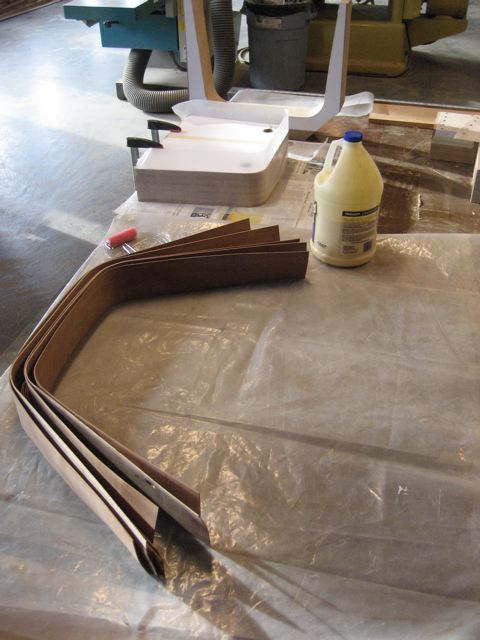Steam-Bending Hardwood Veneer Strips
A description of the hot-pipe method for bending 1/16-inch veneer strips. February 3, 2011
Question
Has anyone has successfully steam bent strips of European pear wood? We are trying to make a curved coffee table base that has a radius of 4". Laminate strips are 1/16" thick. They crack if we try to bend them dry. Iím wondering if I might be able to steam them to make them more like plastic? Everything I've been able to find on the web indicates that pear does not bend well.
Forum Responses
(Furniture Making Forum)
From contributor J:
Iím not sure about the steam bending, but I would try soaking them in hot water for a couple minutes, then pre-bending them to the form with no glue. After they are dry they should hold the shape fairly well, then you can glue the laminations together. I've done this with much smaller radii with food results.
From contributor G:
Use a tried and true hot pipe steaming method used by Luthier's. This is a perfect application. Get a short length of black (steel) pipe, 4 to 6 inches in diameter. Hold it in a vise or mount it on something that wonít burn. Heat the pipe from the inside with a torch to around 250 to 350 deg and then apply and pull the strips around the pipe. The moisture in the wood will steam and it will bend. It takes a bit of practice. There was an article in FWW a year back that showed this. It really works well for thin stock and tight radii. Do not soak the wood, that will raise the MC and you will have all kinds of problems. Steaming does not adversely affect the MC.
From contributor L:
I second most of the above. Bend each layer as accurately as you can to the final radius with the hot pipe. You might consider the electric one. I think it works better than using the torch. I might try misting the side facing the hot pipe with some distilled water, but I wouldn't soak the layers. Bend them, bundle them up with glue (plastic resin) and you're there, I think.
From contributor A:
Although I have not steam bent that particular wood, I have steamed ash and walnut. One golden rule is that steam only works well on green wood. Once the wood is dried (kiln is worse than air), it will not bend well.
From the original questioner:
I think that the hot pipe sounds like the way to go. We ended up cutting the pear into 1/16" veneers and steaming for an hour and then bending in a MDF mold. It worked pretty well, no major cracking or failure. The glue up was difficult - hard to avoid voids. If I decide to make more of these I'm going to go with the pipe. With the local species it is a bit hard to find green pear around here.

Click here for higher quality, full size image
From contributor L:
Two thoughts: first, the widely held notion that KD wood does not bend well is, in my opinion, largely myth. Second, please tell me that bottle of glue in your photo is not what you're actually using to bend these parts.
From the original questioner:
No, not the glue bottle! We used a mold, cut from MDF.
From contributor L:
I was referring to the contents of the glue bottle, not the bottle itself. I was hoping you hadn't used that particular glue for laminating the legs.
From the original questioner:
Yes, we did use the
Titebond2. Do you not recommend it? I'm curious why you don't like it?
From contributor W:
I cut my forms when making something like this. First clamp the center, then the two radii (separate cauls) then the ends again, (separate cauls). Put blocks on the cauls so you can clamp them together end-to-end, and use a disposable outer ply as an inner caul, to distribute pressure between the outer cauls. That will help avoid chronic gaposis.
Anything involving water will raise the MC. Apply water evenly to all pieces you bend, whether soaking or steaming, and let them dry a day or more (but always the same amount) between bending and gluing. Otherwise, as the plies dry the finished pieces will pull in (bend tighter) in differing amounts. The effect will be more profound on thicker laminations and tighter bends.
